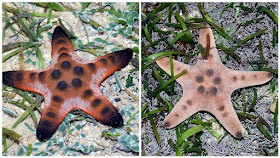Cyrene Reef is ringed by petrochemical plants on Jurong Island and Pulau Bukom. It is also right next to the container terminals on Pasir Panjang. Cyrene Reef has one of the best seagrass meadows in Singapore and its seagrasses are home to lots of marine life!
We saw several baby Knobbly sea stars (Protoreaster nodosus) around the same area. Jianlin and I couldn't resist but place them together for a family portrait.
Here's two more babies! The existence of these juvenile stars shows that the population of sea stars in Cyrene Reef is sustainable as new ones are still being formed.
Jianlin and I also came across several pretty Pentaceraster sea stars (Pentaceraster mammilatus)! These sea stars were first sighted in Singapore waters at Cyrene Reef.
Later on, we found another two of these sea stars! One was in the process of regenerating its arm.
Abundant on the shore this morning would be lots and lots of these White sea urchins (Salmacis sp.). They dot many stretches of the seagrass habitats.
Not as common as the White sea urchins, there were some of the Thorny sea urchins (Prionocidaris sp.) in red and the black Long-spined black sea urchin (Diadema setosum).
This sea cucumber looks like the juvenile version of the uncommon Brown sea cucumber (Bohadschia vitiensis). This sea cucumber has only been recorded intertidally from Cyrene Reef and Semakau.
This sea cucumber with some patterns on its surface could likely also be the Brown sea cucumber (Bohadschia vitiensis). Or probably another species of the same genus. When these sea cucumbers are stressed, they release sticky white cylindrical tubes called Cuvierian tubules as a form of defense mechanism.
At certain stretch of seagrasses, there are a lot more Fan shell clams (Family Pinnidae) than what we usually see on our previous trips.
Similar to our trip yesterday, it seems to be the season where we find very few slugs and flatworms on the intertidal shores. We usually see lots of slugs on Cyrene but I only came across one huge Forskal's sidegill slug (Pleurobranchus forskalii). These slugs usually occur in larger numbers.
Another nudibranch found by Jonathan would be this Blue dragon nudibranch (Pteraeolidia ianthina). It was just next to the sea star that we were photographing but I completely missed this fellow. Haha!
A special sea anemone found among the seagrasses is the Snaky sea anemone (Macrodactyla doreensis) that has snake-like and long tentacles.
A closer look at this sea anemone would enable you to find this commensal Anemone shrimp (Periclimenes brevicarpalis).
Talking about commensals, this is probably my first time seeing an Arrow-head spider crab (Menatheius sp.) residing on the surface of the Haddon's carpet anemones (Stichodactyla haddoni).
Cyrene Reef is one of the few shores where one can find several hard corals such as these Montipora corals (Montipora sp.) among the seagrasses.
Here's a collage showing an assortment of Elbow crabs (Family Parthenopidae) and Arrow-head spider crab (Menatheius sp.) that camouflage very well among the seagrasses. Some of which have sponges, ascidians and even soft corals attached to its body.
This is yet another collage of living critters residing among the blades of seagrasses. They range from hermit crabs, small crabs, snapping shrimps and different types of sea cucumbers.
Steering away from seagrasses for a while, we were trying to find the Grey bonnet snails (Phalium glaucum) and I was relieved to find one towards the end of the trip.
We enjoyed a relatively cool weather with the sun peeking from behind the clouds. The tide ended later than predicted and we stayed on to check out more of Cyrene.
Never did we expect a sudden downpour as the heavens opened! My first reaction was to quickly protect and keep the camera haha! As what Ria said, this is a way of telling us to go home as we were staying longer than planned.
The downpour came and left in a sudden. And we were greeted with a lovely rainbow as we depart from Cyrene Reef. :)























No comments:
Post a Comment